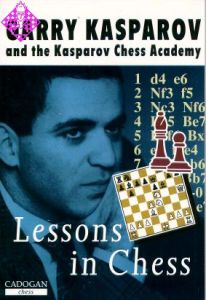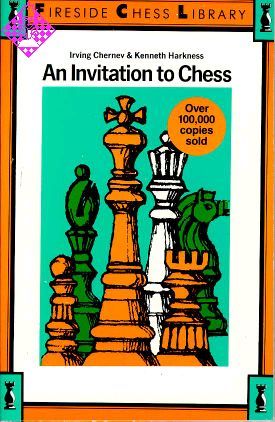This chess book is unique in several ways.
It is specifically designed for persons who don't know one chess piece from another.
It gives beginners a solid foundation and approach to the game through a pictorial presentation of the moves and their meanings. The hundreds of photographs and diagrams instruct the novice simply and forcefully, doing away with labored and involved explanations which make other books for beginners such tough going.
An Invitation to Chess does not pretend that it can turn beginners into experts. Rather, it is designed to bring the student to a point where he can sit down and play a game with enjoyment and understand what he is doing and how much he still has to learn.
It is an invaluable primer for those tens of thousands of persons who have "always wanted to play the game but never found time to learn."
It is specifically designed for persons who don't know one chess piece from another.
It gives beginners a solid foundation and approach to the game through a pictorial presentation of the moves and their meanings. The hundreds of photographs and diagrams instruct the novice simply and forcefully, doing away with labored and involved explanations which make other books for beginners such tough going.
An Invitation to Chess does not pretend that it can turn beginners into experts. Rather, it is designed to bring the student to a point where he can sit down and play a game with enjoyment and understand what he is doing and how much he still has to learn.
It is an invaluable primer for those tens of thousands of persons who have "always wanted to play the game but never found time to learn."
| EAN | 1857444574 |
|---|---|
| Weight | 270 g |
| Manufacturer | Cadogan |
| Width | 14 cm |
| Height | 21.5 cm |
| Medium | Book |
| Year of Publication | 1985 |
| Author | Irving ChernevKenneth Harkness |
| Language | English |
| ISBN-10 | 1857444574 |
| Pages | 221 |
| Binding | paperback |
| Name | Cadogan Books |
|---|
007 FOREWORD
011 Part One:
THE RULES OF CHESS
011 The Chessmen and Chessboard
013 The Starting Line-Up
015 The Moves of the Chessmen
016 How the King Moves and Captures
017 How the Rook Moves and Captures
018 How the Bishop Moves and Captures
019 How the Queen Moves and Captures
020 How the Knight Leaps and Captures
022 How the Pawn Moves
023 The Pawn's Initial Move
024 How the Pawn Captures
026 How Pawns Move in Chess Diagrams
027 Obstructions and Captures
029 The White Queen Captures a Black Pawn
030 The Object of the Game
034 Checking the King
036 Getting Out of Check
038 Checkmating the King
041 Movie of a Chess Game
042 How the Chessmen Are Named
044 The Moves
067 Safeguarding the King
069 How to Castle with King and Rook
071 Rules on Castling
073 Castle Early in Game
074 Illustrative Game
077 Illegal Exposure to Check
078 The Power of the Pawn
079 Pawn Promotion
083 How the Pawn Captures "en passant"
086 How Games Are Drawn
087 Drawn Positions Without Pawns
089 Technically Drawn Games
090 Draw by Stalemate
093 Draw by Perpetual Check
094 Draw by Repetition
095 Part Two: BASIC PRINCIPLES
095 Relative Values of the Chessmen
098 Examples of Exchanges
101 Superior Force Should Win
104 Rules for Learners
104 How to Meet Capturing Threats
108 Threats and Counter - Threats
111 What Does He Threaten?
112 Illustrative Game
123 The Principle of Mobility
126 How Mobility Wins
129 Illustrative Game
139 Part Three: OPENING PRINCIPLES
139 Outline of Opening Principles
143 Mistakes in the Opening
145 Premature Attacks
153 Pawn-Grabbing with the Queen
157 Exposing the Queen to Attack
159 Unnecessary Pawn Moves
168 Moving the Same Piece Twice
174 Correct Opening Strategy
175 Control of the Center
181 Examples of Center Control
189 Summary of Opening Procedure
194 How; Development Wins
207 Part Four: CHESS COMBINATIONS
207 The Artistry of Chess
209 A Chess Combination
011 Part One:
THE RULES OF CHESS
011 The Chessmen and Chessboard
013 The Starting Line-Up
015 The Moves of the Chessmen
016 How the King Moves and Captures
017 How the Rook Moves and Captures
018 How the Bishop Moves and Captures
019 How the Queen Moves and Captures
020 How the Knight Leaps and Captures
022 How the Pawn Moves
023 The Pawn's Initial Move
024 How the Pawn Captures
026 How Pawns Move in Chess Diagrams
027 Obstructions and Captures
029 The White Queen Captures a Black Pawn
030 The Object of the Game
034 Checking the King
036 Getting Out of Check
038 Checkmating the King
041 Movie of a Chess Game
042 How the Chessmen Are Named
044 The Moves
067 Safeguarding the King
069 How to Castle with King and Rook
071 Rules on Castling
073 Castle Early in Game
074 Illustrative Game
077 Illegal Exposure to Check
078 The Power of the Pawn
079 Pawn Promotion
083 How the Pawn Captures "en passant"
086 How Games Are Drawn
087 Drawn Positions Without Pawns
089 Technically Drawn Games
090 Draw by Stalemate
093 Draw by Perpetual Check
094 Draw by Repetition
095 Part Two: BASIC PRINCIPLES
095 Relative Values of the Chessmen
098 Examples of Exchanges
101 Superior Force Should Win
104 Rules for Learners
104 How to Meet Capturing Threats
108 Threats and Counter - Threats
111 What Does He Threaten?
112 Illustrative Game
123 The Principle of Mobility
126 How Mobility Wins
129 Illustrative Game
139 Part Three: OPENING PRINCIPLES
139 Outline of Opening Principles
143 Mistakes in the Opening
145 Premature Attacks
153 Pawn-Grabbing with the Queen
157 Exposing the Queen to Attack
159 Unnecessary Pawn Moves
168 Moving the Same Piece Twice
174 Correct Opening Strategy
175 Control of the Center
181 Examples of Center Control
189 Summary of Opening Procedure
194 How; Development Wins
207 Part Four: CHESS COMBINATIONS
207 The Artistry of Chess
209 A Chess Combination
More from Cadogan
-
 Lessons in Chess€18.50
Lessons in Chess€18.50 -
 Learn Chess€18.95
Learn Chess€18.95

